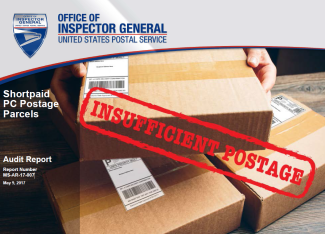Shortpaid PC Postage Parcels
Background
PC Postage is a service offered by the U.S. Postal Service that allows customers to print U.S. postage stamps with their own printers. Customers access PC Postage through USPS.com or PC Postage vendors licensed by the Postal Service. The Postal Service recorded PC Postage revenues of about $[redacted] billion in fiscal year (FY) 2016.
PC Postage customers establish an account – either on USPS.com or with an authorized PC Postage provider – and compute and print postage through the Internet using a computer and printer. PC Postage parcels are entered into the Postal Service mailstream via collection boxes, carrier pickup, and counters at Postal Service retail units.
In September 2013, we reported that the Postal Service’s internal controls for PC Postage parcels were inadequate and the Postal Service estimated $[redacted] million in shortpaid postage (postage that was either underpaid or not paid). We recommended corrective interim controls and automated systems. The Postal Service disagreed and instead decided to review its automated verification capabilities.
The Postal Service is currently developing an automated verification solution known as the Automated Package Verification (APV) system. APV would use data collected from mail processing equipment to automate identification and recovery of shortpaid PC Postage parcels. APV has a projected cost of almost $[redacted] million, and is expected to evaluate almost [redacted] percent of all PC Postage parcels for accurate postage. It was to be implemented in January 2017, but has been delayed to August 2017.
Our objective was to evaluate Postal Service controls to identify and collect shortpaid postage on PC Postage parcels.
What the OIG Found
The Postal Service has implemented limited controls for identifying and collecting shortpaid PC Postage parcels since our September 2013 audit. Such efforts have included information sharing between the Postal Service and the PC Postage providers and manual assessments by the Postal Service. These efforts, however, have had very minor impact, as estimated shortpaid postage for these parcels has grown to $[redacted] million in FY 2016.
The Postal Service expects APV to adequately address the risks associated with shortpaid PC postage. However, this system, which was originally scheduled to be implemented in January 2017, has now been delayed until August 2017. Although notable progress has been made in regard to some equipment development and systems integration, we believe APV implementation continues to be at risk for additional delays and issues including:
- Equipment — delays have occurred in scanner and scale deployment, testing, and calibration. For example, the equipment designed to evaluate oversized parcels will not be installed until the end of April 2017.
- Software — scope of systems testing has been limited, software issues remain, and collection and payment systems are incomplete.
- Customer Service Center — staffing, training, and process development for the customer service center are all behind schedule, which exacerbates PC Postage mailers’ concerns about key program aspects such as the dispute processes.
While we recognize the current challenges, we believe management should consider establishing additional interim controls while APV is being developed and deployed. These controls include leveraging resources, available data, and technologies, such as:
- Expand Postal Service Revenue Assurance efforts to identify and collect shortpaid postage by leveraging existing data systems.
- Leverage data and Passive Adaptive Scanning System technology to help identify and sample suspected shortpaid packages at delivery units.
These interim controls would help identify shortpaid postage and provide an enhanced deterrent until APV is implemented. Also, once APV is implemented, these controls could be refocused on the [redacted] percent of PC Postage parcels that would not be tested using APV.
What the OIG Recommended
We recommended management establish additional controls for identifying and collecting shortpaid postage on PC Postage parcels, such as leveraging resources, data, and technologies, until APV is implemented, and develop a strategy for refocusing the shortpaid controls to the segment of PC Postage parcels that will not be tested by APV once it is implemented.

